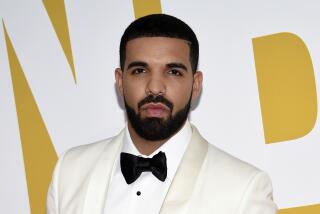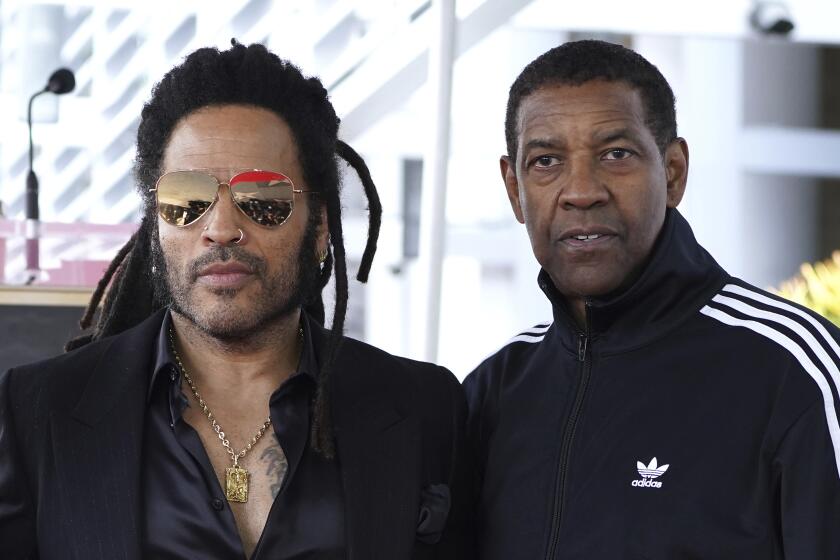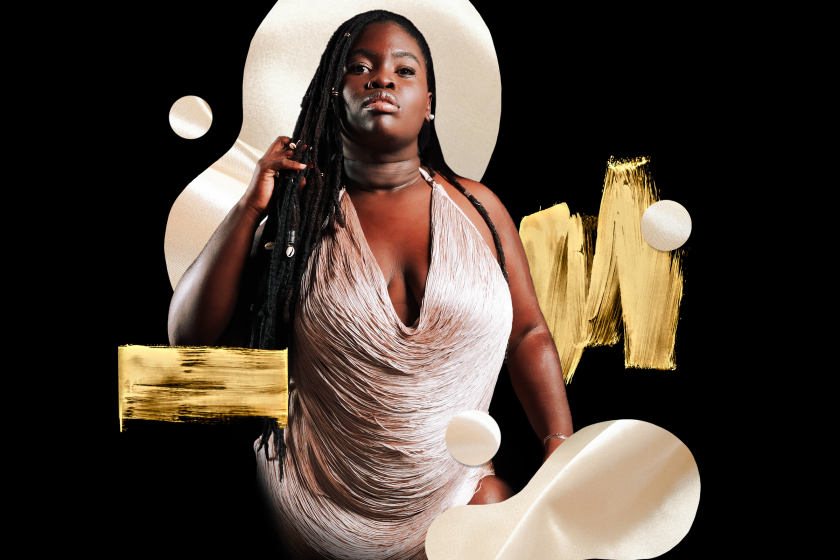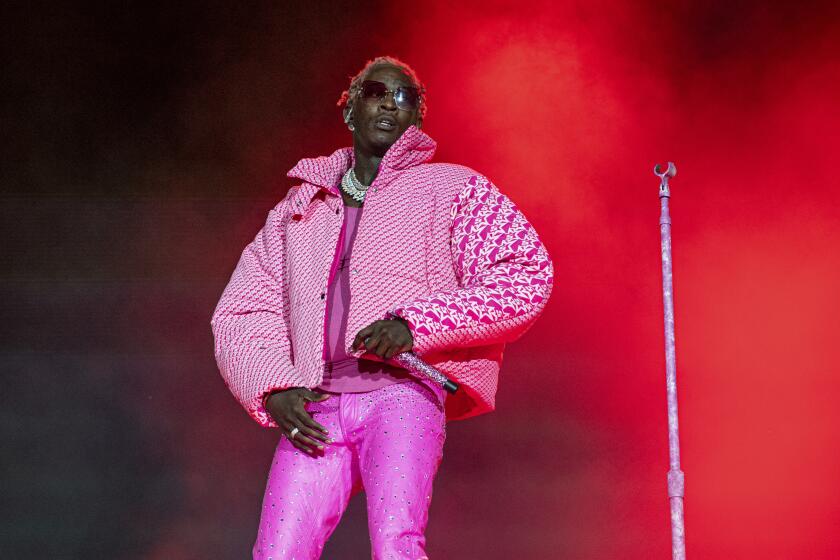Hall, or Nothing at All
The argument over the Rock and Roll Hall of Fame balloting each year revolves around which musicians to induct. Why, say, are Rick Nelson and the Four Seasons in? Why are Ritchie Valens and the Moody Blues out?
Don’t expect it to be any different this fall when Hall of Fame voters--about 1,000 critics, musicians and record company executives--debate the merits of such eligible artists as AC/DC, Aerosmith, Black Sabbath, the O’Jays, Queen and Steely Dan.
But here’s one prediction.
No singer, musician or songwriter voted into the Class of 2000 will have had as much influence on the masters of rock ‘n’ roll as Frank Sinatra.
The fact that Sinatra has been consistently bypassed in the “early influence” category (which does include such acts as Louis Armstrong, Bob Wills and Woody Guthrie) is one of the Hall of Fame’s most glaring--if not altogether unpredictable--blind spots, and it’s time that it be addressed.
It may be hard for many rock enthusiasts to recognize Sinatra’s influence on the field because he was long seen as the enemy--a pop traditionalist who not only stood apart from rock music, but also vigorously opposed it.
But the issue isn’t Sinatra’s style of music, nor his personal taste. We’re only concerned with his legacy and his impact on rock.
On that scale, I’ve got plenty of corroborating witnesses.
How about, for starters, the testimony of Bob Dylan, Bruce Springsteen, Neil Young, Van Morrison, Bobby Darin and Joni Mitchell--Rock Hall of Fame members who have sung his music or cited his influence.
“Rock ‘n’ roll people love Frank Sinatra because [he] has got what we want: swagger and attitude,” U2’s Bono said playfully in presenting Sinatra with a Grammy Legend award in 1994. “Rock ‘n’ roll plays at being tough, but this guy’s . . . well he’s the Boss . . . the Man . . . Big Daddy . . . the Big Bang of Pop. I’m not gonna mess with him--are you?”
When asked for a statement after Sinatra’s death, Dylan said, “[Sinatra’s] music had a profound influence on me, whether I knew it or not.”
The remark is revealing because it speaks to the heart of the issue of Sinatra’s being seen as someone separate from rock.
There’s a humorous scene in “No Direction Home,” Robert Shelton’s biography of Dylan, where Dylan is on the phone in the mid-’60s with his manager, Albert Grossman, who is telling him excitedly that Sinatra may be interested in recording Dylan’s song “Sad-Eyed Lady of the Lowlands.”
As Shelton tells it, Dylan pauses, then says, “What about Otis Redding? I’d rather he do it.”
In the ‘50s, Sinatra was indiscriminately lumped by most young rock fans into the enemy camp with Eddie Fisher, Patti Page and the rest of polite, adult pop. If Elvis was the king of rock, Frank was the monarch of pop--and that led to a lot of “my favorite is better than your favorite” squabbling between teens and parents.
So you can imagine the surprise on both sides when Presley and Sinatra teamed up on Sinatra’s ABC television show in May 1960. Sinatra put aside his reservations about rock in hopes of boosting his ratings, presenting Presley in his first appearance after his Army stint.
Watching a tape of that broadcast now, it’s amusing to see how uneasy Sinatra is as he sings a Presley hit (“Love Me Tender”), and then how Presley good-naturedly salutes Sinatra’s finger-snapping cockiness as he sings a Sinatra hit (“Witchcraft”).
That cool, confident attitude is a great part of the Sinatra contribution to rock--but it’s not all. In his toast to Sinatra, Dylan pinpointed the essence of Sinatra’s art and his impact on rock when he said, “He was one of the very few singers who sang without a mask.”
Until Sinatra, pop singers did mostly sing with a mask--in the sense that they didn’t reveal their deepest feelings. That’s why rock drew most of its energy and inspiration from the blues, country and folk fields, where emotion felt more authentic and deeply rooted.
But Sinatra demonstrated that you could inject passion into the pop mainstream, an approach that he mastered by studying the crooning and personalized phrasing of Bing Crosby and the raw intensity of Billie Holiday. Though he wasn’t a songwriter, Sinatra made a song’s story his own.
There was such a convincing emotion in Sinatra’s work that I, as a young rock fan, turned to his music in the early ‘60s when rock went into its first decline. I found more of Elvis and Buddy Holly in Sinatra’s zesty renditions of “I Love Paris” and “The Lady Is a Tramp” than in the new wave of young pop singers--the Bobby Vees and Bobby Vintons--who ruled the airwaves.
It was only after Dylan and the Beatles surfaced in the mid-’60s and brought their own stories and emotion to the music that I regained my enthusiasm for rock. But I never lost my appreciation for Sinatra, and I don’t think the great rock artists over the years did either.
If Sinatra, in fact, had grown up in the rock-dominated ‘60s rather than the big-band era, he might well have joined all those other New Jersey musicians and formed a rock band. Musicians tend to gravitate toward the musical style of their generation. Chuck Berry today would probably be a rapper. Jimi Hendrix might likely be revolutionizing the synthesizer.
In Sinatra’s case, he might have put together an interesting synthesis between melodic rock and pre-rock musical sophistication in the manner of Elvis Costello or Bryan Ferry.
The best example of Sinatra as rocker was his scorching, R&B-slanted; 1966 recording of “That’s Life,” a song that expressed his own personal and professional ups and downs. Van Morrison toasted Sinatra by doing the song on his 1998 tour with Bob Dylan and Joni Mitchell, but his treatment didn’t come close to the authority of Sinatra’s.
Sinatra’s music was filled with the grand, dramatic gesture and a supreme belief in possibilities. However different the melodic structure, you feel in the declaration of “New York, New York” the same uncompromising belief and desire that you find in the most liberating idealism of great rock ‘n’ roll.
That connection was made public when Dylan, Springsteen, Ray Charles, Little Richard and Bono joined in a moving tribute to Sinatra during his 80th birthday salute in November 1995 at the Shrine Auditorium.
It was a revolutionary moment in which two traditions came together. Springsteen sang “Angel Eyes,” a ballad associated with Sinatra, and spoke about Sinatra’s influence. In a videotaped appearance, Bono sang a song that he wrote for Sinatra and showed his affection for the guest of honor by planting a kiss on the camera lens.
But it was Dylan who best summarized the bond that night by closing the TV special with a song that you could easily assume was patterned after the declaration of personal independence in the Sinatra theme song, “My Way”--except it was written years before “My Way.”
In 1964’s “Restless Farewell,” Dylan wrote, “So I’ll make my stand and remain as I am/And bid farewell and not give a damn.”
It was a touching moment that cut through generations and musical styles to salute sheer artistry--and to acknowledge a debt to a master. It’s a connection that the Rock and Roll Hall of Fame brain trust needs to acknowledge when it makes its Class of 2000 choices this summer.
* Hilburn is a member of the Rock and Roll Hall of Fame nominating committee, which chooses the artists who go on the final ballot. The committee is not involved in choosing the “early influence” nominees.
*
Robert Hilburn, The Times’ pop music critic, can be reached at robert.hilburn@latimes.com.
More to Read
The biggest entertainment stories
Get our big stories about Hollywood, film, television, music, arts, culture and more right in your inbox as soon as they publish.
You may occasionally receive promotional content from the Los Angeles Times.






